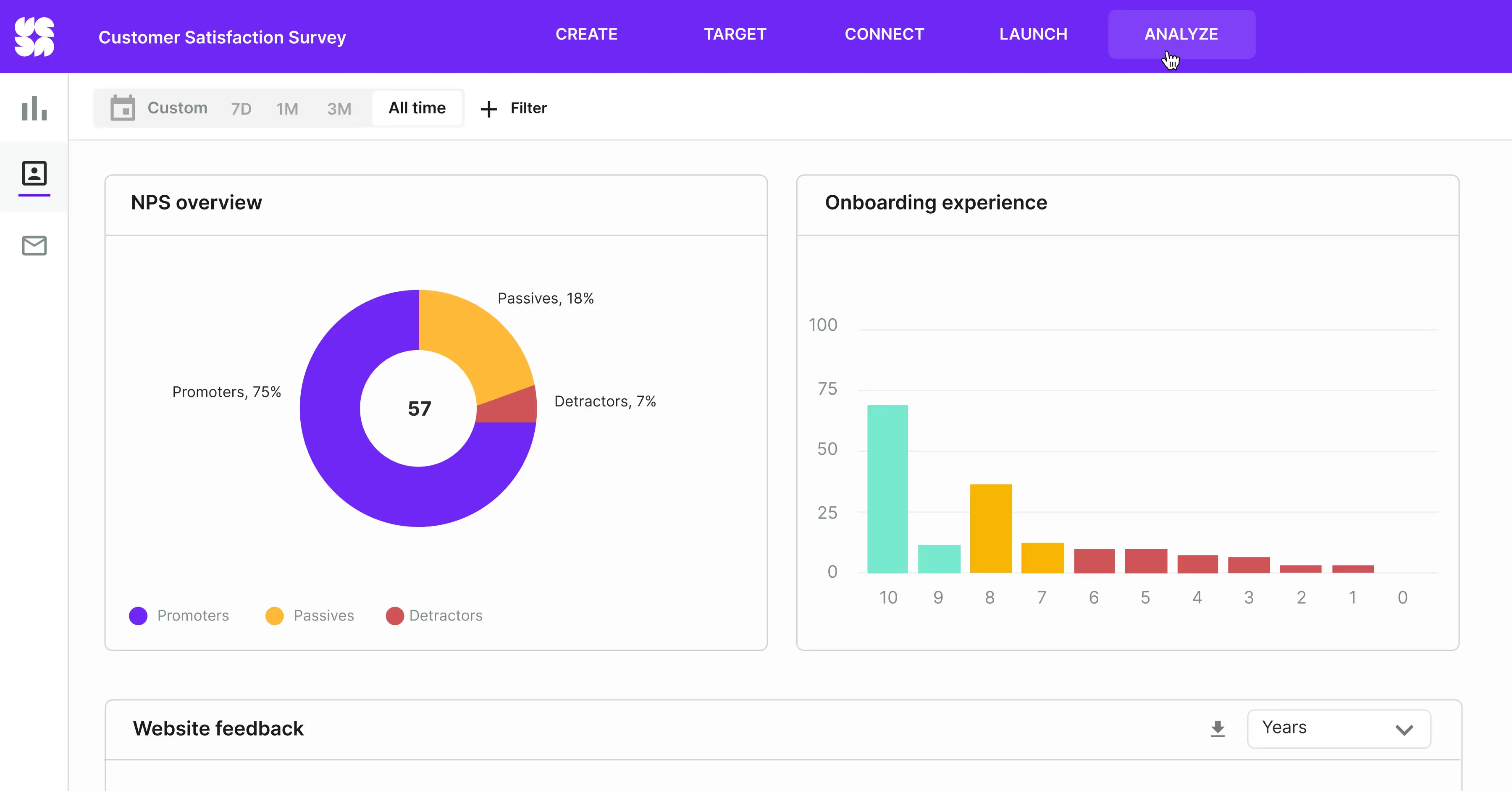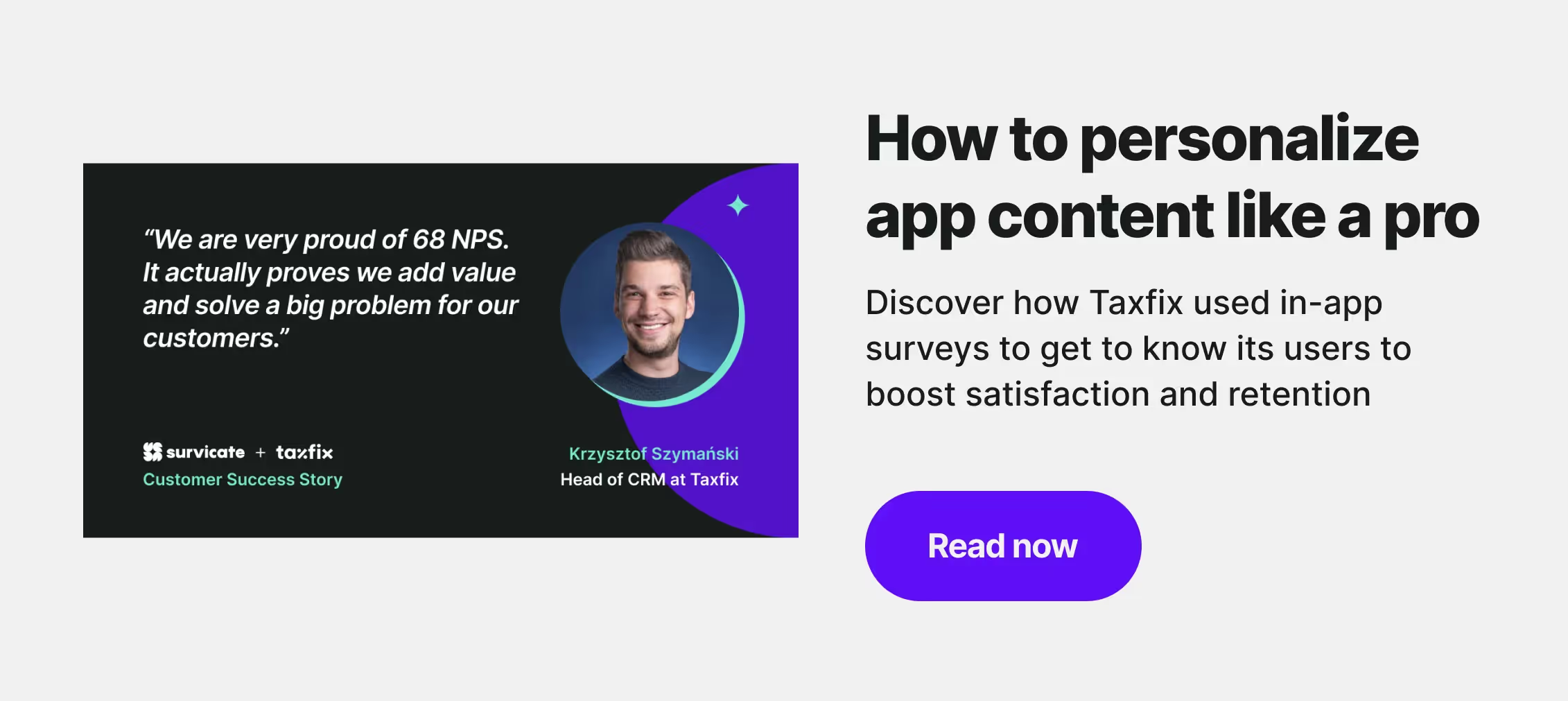Let’s start with a question: How much time do you spend scrolling on your mobile each day?
We won’t judge. Pinky promise 🤞
Too much? Yeah, we feel you. So, you probably already know how app experience can make or break your vibe.
This guide is to structure your knowledge about essential metrics and KPIs, the importance of user feedback, and how to smartly use them to improve your app’s experience.
Let’s get down to scrolling 📱

What is the mobile app experience?
Mobile app experience refers to how users feel when they use a mobile app. It includes factors such as ease of use (app UX), visual design (app UI), performance speed, and available features. A good mobile experience is crucial for user engagement, satisfaction, and retention.
To create a successful mobile experience, you should focus on understanding user needs, conducting user research, following platform-specific design guidelines (e.g., iOS and Android), and continuously iterating based on user feedback and analytics.
Why is mobile app experience important?
The short answer—that people want to enjoy using the app. Now for the long one ⤵️
Impacts user engagement
The quality of a mobile app experience directly and significantly impacts user engagement.
When users find an app intuitive, responsive, and enjoyable to use, they are more likely to interact with it frequently and explore its features more deeply. Their sessions are longer, visits more regular, and with more interactions, be it browsing content, making purchases, or participating in community features.
On the other hand, a poor mobile experience—you know: slow load times, confusing navigation, or frequent crashes—will lead to frustration, causing users to leave the app and seek alternatives.
High user engagement is crucial for mobile apps. It can also be an important factor in your conversion rate optimization efforts.
Boosts customer satisfaction and loyalty
A positive mobile app experience is essential for boosting customer satisfaction and building loyalty.
When the app is easy to navigate, visually appealing, and tailored to user needs, people are more likely to feel satisfied. And satisfaction translates into loyalty, with users returning to the app regularly and potentially becoming brand advocates.
And, of course, satisfied users are more likely to leave positive reviews and recommend the app to others, improving user acquisition just like that.
Serves as a competitive differentiator
There are 8.93 million different smartphone apps worldwide, and with the countless app options at users’ fingertips, a seamless mobile app experience can be a critical competitive differentiator.
It comes with zero surprise—in the end, people prefer to use apps that don’t crash on them, don’t make them think, and are overall a pleasant experience to use. It’s even more important in crowded industries such as e-commerce, finance, or social networking.
Influences brand perception
The app experience affects how people view the brand behind it. The more functional, intuitive, and user-friendly the app, the more positively it will affect the brand.
And, of course, positive perception can enhance the overall brand image, leading users to trust the brand more and feel confident in its products or services.
Conversely, a poorly executed app experience can harm your brand’s reputation, suggesting a lack of attention to detail or disregard for users.
How to measure mobile experience
To assess your mobile app experience, you need to measure it. The most obvious choice will be quantitative data coming from your app analytics and session tracking.
Mobile app analytics is the essential source of truth when it comes to basic app health. There are countless metrics you can track, but the rule of thumb is that you choose those genuinely relevant to your goals.
Nonetheless, there is a so-called golden business standard for mobile app KPIs you should be following no matter the industry you’re in.
1. User acquisition metrics
💾Downloads
The number of times your app is downloaded is a fundamental metric that indicates its reach and popularity. However, downloads alone don’t provide a complete picture of user engagement.
💰Cost Per Install (CPI)
Cost Per Install measures the average cost associated with acquiring new users through paid advertising campaigns. Your aim here is to keep it as low as possible through an efficient marketing strategy. Monitoring CPI helps optimize your marketing spend and improve the ROI of your user acquisition efforts.
2. User engagement metrics
⏱️Session length
Session length shows the average duration of user sessions in your app. Longer sessions typically mean that users find value in the app and are engaging deeply with its content.
🤳Session frequency
As the name suggests, session frequency measures how often users return to your app within a given time frame. Higher session frequency translates into app stickiness; in other words, that users find your app indispensable in their daily or weekly routines.
3. User retention metrics
❌Churn rate
The churn rate is the percentage of users who stop using your app after a certain period. A high churn rate means that users don’t find lasting value in the app, which can be a sign of poor user experience or unmet needs.
🗓️Daily/Monthly Active Users (DAU/MAU)
These metrics track the number of unique users who engage with your app on a daily or monthly basis. A high DAU/MAU ratio suggests strong user retention and loyalty, while a low ratio may indicate issues with the overall app experience.
4. User conversion metrics
🛒In-app purchases
The number of in-app purchases reflects the revenue generated from users making purchases within the app. It’s a critical indicator of how effectively your app monetizes its user base. Tracking in-app purchases helps you understand the effectiveness of your app’s monetization strategy.
🖱️Ad clicks
For mobile apps that rely on advertising revenue, tracking ad clicks is essential. This metric shows how often users interact with ads within your app.
Just remember, although higher ad click rates can lead to increased revenue, it’s important to balance this with user experience to avoid making the app feel too cluttered with ads.
Encourage users to leave in-app feedback
Tracking mobile app experience through numbers only brings half of the truth to the plate. To get to know what users love (or hate, for that matter), you should dig into the qualitative feedback such as that coming from in-app surveys, online reviews, or direct interactions with your support teams.
Benefits of in-app surveys
Let’s look at how in-app surveys can benefit your app experience:
- They’re contextual, meaning you use them at the right time and place. For example, if you’d like to ask users how they evaluate a new feature, you can set up an in-app survey to be triggered directly after they interact with it. This kind of context-specific information is more relevant and actionable.
- In-app feedback allows you to gather real-time insights into how users adopt your product. It can help identify user frustration, friction points, and usability issues, as well as areas where users are particularly satisfied with a seamless experience.
- Regularly collecting and analyzing in-app feedback helps you continuously improve the app experience.
Popular in-app survey types
NPS survey
Net Promoter Score is a type of survey that helps you understand the overall loyalty and satisfaction with your app. It also segments your users into three groups depending on what score they choose (promoters, passives, detractors).
💡Tip: By adding additional questions, you can improve your app’s personalization, like Taxfix, which takes advantage of the NPS to get to know more about its users ⤵️
“We ask three questions that help us classify our users and put them into one of our targeting groups. And then that information is also saved in Braze, our CRM tool, and the team uses that for content personalization.”
Krzysztof Szymański, Former Head of CRM at Taxfix
Customer satisfaction (CSAT) survey
CSAT surveys are a great way to check how satisfied your users are immediately after using a feature or a product, or completing certain action within your app.
💡Tip: It’s usually measured on a 5-point scale, but you can also use a smiley scale to get more traction on mobile.
User Effort Score (UES) survey
UES survey is a good choice if you want to understand how users perceive the ease of your app’s experience.
💡Tip: Deploy effort score surveys after you introduce a new feature or flow to make sure you keep the app experience effortless.
Product-market fit survey
Product-market fit surveys provide valuable feedback when you’ve launched a new app, helping you assess how well it meets market demand.
💡Tip: Just like Landing, you can search for the right value proposition that will help you achieve success in your industry.
We've had the same Product-Market Fit survey running since October 2021. It is something we kept running no matter what else changed. There's a litany of ways that we use it. Number one is to see what people say is the main benefit of Landing. It translates into the value prop that we are providing for people.
Liz Friedland, Head of Community at Landing
Welcome surveys
Personalization is key to engaging your app users, so starting with a welcome survey to collect basic information is a great idea.
💡Tip: Apart from the typical questions about name or preferred frequency of app updates, ask about something specific to your field to get more relevant insights.

Analyze open-text feedback with customer feedback analytics
After you collect user feedback, you need to analyze it to extract actionable insights. Customer feedback analytics tools helps you analyze feedback gathered from various sources, including in-app feedback, support tickets, online reviews, and user surveys.

For example, the Survicate dashboard provides a real-time analysis of all your in-app surveys, and automatically counts CSAT, CES, or NPS scores.

Additionally, AI-powered tools such as Insights Hub categorize your open-text feedback into themes or topics (e.g., user interface, performance, features), so you can prioritize development efforts based on the most frequently mentioned issues or requests.
For more detailed queries, you can use a chat-based Research Assistant which uses all your available feedback that you connected to answer any question you might have about your users’ opinions.
Keep your finger on online reviews and app ratings
Online reviews and app ratings are public-facing indicators of user satisfaction and mobile app experience. They are typically visible in app stores (such as the Apple App Store or Google Play Store) and can significantly influence the app's reputation and download rates.
User sentiment
App ratings provide a quick snapshot of user sentiment, with higher ratings generally translating into a more positive user experience. Reviews, on the other hand, offer detailed user opinions that can reveal specific app strengths and weaknesses.
App Store Optimization (ASO)
Positive reviews and high ratings improve your app’s visibility in app stores through better ranking, and this can lead to more downloads. Conversely, negative reviews can deter potential users from downloading the app, highlighting the importance of maintaining a strong mobile experience.
🚨Remember: With fewer stars, the app downloads decrease dramatically—up to 50% of users sidestep 3-star apps, and nearly 85% avoid those with a 2-star rating.
50% of users sidestepping 3-star apps and nearly 85% avoiding those with a 2-star rating.
Response strategy
Engage with users by responding to reviews—especially negative ones. It demonstrates that you value user feedback and are committed to improving the app. This can help mitigate the impact of negative reviews and build trust with your user base.
Session tracking
Session tracking monitors and analyzes the interactions users have with your app during a single session. It provides detailed insights into user behavior, helping you understand how users navigate the app, which features they engage with, and where they encounter difficulties.
User flow analysis
Session tracking allows you to visualize the digital journey through the app, identifying common paths users take and where they might drop off. This can help you optimize the user interface and improve overall usability.
Heatmaps and click tracking
Tools that generate heatmaps and track clicks within the app can show which areas of the screen users interact with the most and which areas are ignored. This information helps refine the app’s design and ensure that key features are easily accessible.

Session recording
Session recording takes session tracking a step further by capturing videos of actual user interactions within the app. It allows you to see exactly how users navigate the app in real time, providing a visual understanding of user behavior.
By reviewing session recordings, you can identify specific user actions, observe how they interact with different elements, and pinpoint issues that may not be apparent through data alone.
💡Tip: To get an integrated view of the user, consider using Survicate integrated with a session recording tool such as FullStory.
I use FullStory hand in hand with Survicate. It's given us a chance to peer over a user's shoulder and see what they're doing within a session. And that, in combination with hearing what users are reporting through Survicate, has been huge.
Katherine Crutchfield, UXR Lead at Landing
How to improve mobile app experience
Improving the app experience is crucial for retaining users, driving engagement, and ensuring the success of your app. Let’s go through some key strategies to enhance the mobile experience by addressing gaps, gathering and acting on user feedback, and personalizing content.
Find the gaps in the app experience
The first step in improving the mobile experience is identifying where the app falls short. This requires a thorough analysis of the user journey to pinpoint pain points, bottlenecks, and areas of friction that detract from the overall experience.
User journey mapping
Create detailed maps of how users navigate through your app, from onboarding to key interactions. This helps you identify where users might get stuck, lose interest, or abandon the app altogether.
Analytics and performance data
Use analytics tools to track user behavior and app performance metrics, such as load times, error rates, and user drop-off points. This data can reveal hidden issues that might not be immediately obvious from user feedback alone.
Competitive analysis
Compare your app’s experience with that of competitors to identify gaps. Understanding what your competitors are doing well—and where they fall short—can provide insights into how to enhance your own app’s experience.
Gather user feedback
Collecting user feedback is essential for understanding the real-world experience of your app's users. Feedback provides direct insights into what users like, what frustrates them, and what features they would like to see in future updates.
In-app surveys
Set up targeted surveys within your app to ask users about specific features or their overall satisfaction.
Remember to time these surveys appropriately, for instance,after a key interaction, so you can gather more relevant and actionable insights.
💡For example, Taxfix set its two NPS surveys after crucial user actions: first, after users file their tax declaration, and second, after they receive their refund from the tax office.
The NPS survey is the company’s main source of insights. Apart from the main NPS question, Taxfix asks three additional questions to better segment its audience and personalize the content they receive.
What's the likelihood of someone who gave us a very low score to refer us to their friend? Probably low. And then, at the same time, there’s no relevancy. If someone gives us a score of one and the next message they get is like, ‘Hey, refer us to their friend,’ as a customer, I would feel like, okay, these guys have no idea what they are doing.
Krzysztof Szymański, Former Head of CRM at Taxfix
App Store reviews
Regularly monitor app store reviews and ratings to gather unsolicited feedback. Pay attention to recurring themes in both positive and negative reviews to make sure you know the pain points your customers may have.
🚨Remember: Make it a habit to respond to every single review you get, no matter if it’s good or bad. If there’s an immediate solution to user’s technical issues, share it. If not, let the user know you’ve acknowledged it and will update them when it’s resolved.
The thing is to make your reviewers feel valued and heard; after all, they took their personal time to share the feedback and it can make your app better.
Personalize content
Personalizing content is a powerful way to improve the mobile experience, making the app feel more relevant and engaging to each individual user.
To personalize communication with your app users, consider delivering the right message to the right person at the right place and time.

We believe that dealing with the topic of personalized finance requires trust. The way I think about it is that you enable trust through relevancy, and that can only happen if the customer feels that you understand them, right?
We want to be close, and we combine qualitative and quantitative data to create a user profile and understand their personal preferences. It's really important to us not to guess.
Krzysztof Szymański, Former Head of CRM at Taxfix
Let’s have a look at personalization, from a practical perspective ⤵️
Use behavioral data
Use data on user behavior, preferences, and past interactions to deliver personalized content, recommendations, and features.
If I know that for the last three years, you've always been filing a few days before the deadline, the likelihood of me changing this behavior and forcing you to file in January is rather low.
Krzysztof Szymański, Former Head of CRM at Taxfix
Segmentation
Segment your user base and tailor content to different groups based on their interests, demographics, or usage patterns. This ensures that users receive content that is most relevant to them, increasing satisfaction and retention.

Close the feedback loop
Closing the feedback loop is all about making sure users know that their feedback has been heard and acted upon. This not only improves the app but also builds trust and loyalty among users.

Communicate changes
When implementing updates based on user feedback, communicate these changes clearly through app updates, release notes, or in-app notifications. Let users know that their input directly contributed to these improvements.
Follow-up surveys
After making changes, send follow-up surveys to users to gather feedback on the new experience. This helps validate whether the improvements had the desired effect and provides insights for further refinement.
Engage with users
Actively engage with users who leave feedback, particularly in public forums like app store reviews. Thank them for their input and let them know how it’s being used to improve the app. It shows users that you value their opinions and also encourages their ongoing engagement.













.svg)

.svg)



